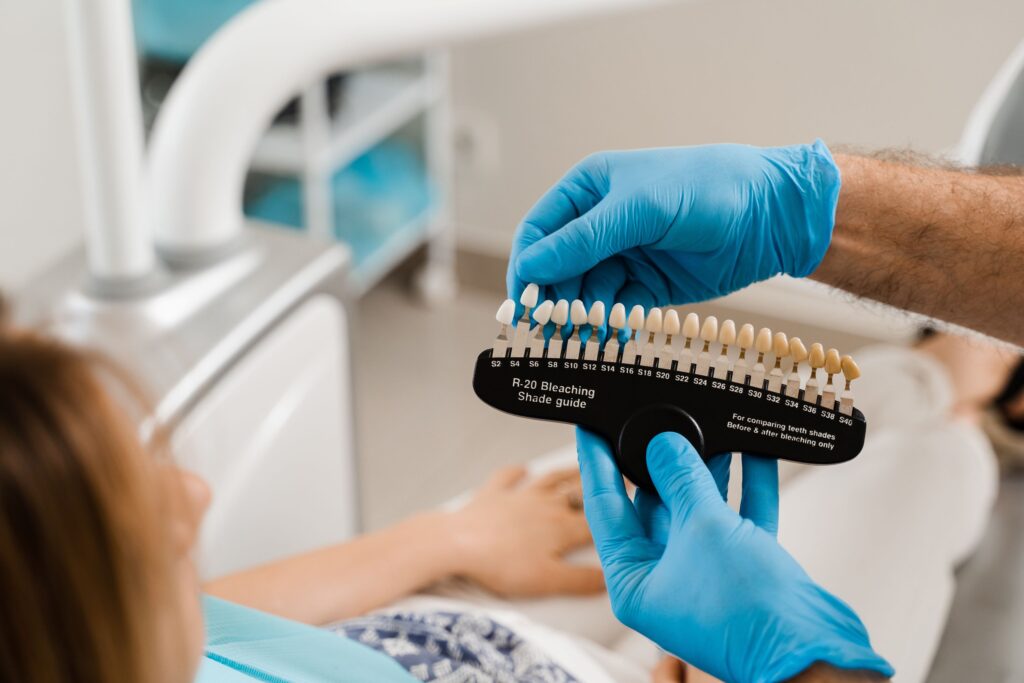
If you have a severely decayed or damaged tooth that can’t be fixed with a filling, or recently had a root canal, your dentist will likely restore it with a dental crown. You might wonder whether your prosthetic will look bulky or out of place, but thankfully, that’s not usually the case!
Your new tooth can be customized to match the shape, size, and hue of your natural teeth for lifelike results, though it’s normal to have questions about what’s involved in the process. Continue reading to learn more about how your dentist matches your crown to blend seamlessly with your smile!
What Are Dental Crowns?
Dental crowns are tooth-shaped caps that are cemented over damaged teeth to protect them, to anchor dental bridges in place, or to cover dental implants to close spaces in your smile left behind by missing teeth. They typically last anywhere from 5 to 15 or more years, depending on how well they’re maintained.
Historically, these repairs were made from amalgam metal mixtures that weren’t biocompatible and could conduct hot and cold temperatures, resulting in sensitivity. Not only that, but the gray material was easily noticeable and detracted from patients’ appearance. Today, your dentist uses resilient tooth-colored materials, like ceramic or resin, that can be customized to look just like the teeth you were born with.
What is the Dental Crown Process?
Getting dental crowns often involves a few appointments over several weeks because your restoration is customized at each step of its design and creation. First, your dentist must examine your mouth to verify that it’s the best solution to meet your needs. If they find signs of cavities or gum disease that might interfere, they’ll treat those first.
Then, they’ll clear away any decayed or infected materials from your tooth and remove a small amount of enamel so that your restoration fits correctly without looking overly large next to neighboring teeth. Next, they’ll make impressions of your teeth and gums to ensure a proper fit. Once you and your dentist have selected a shade, they’ll send the information to a dental lab to start building your prosthetic.
How are Dental Crowns Color-Matched?
There are a couple of methods that can help your provider select just the right tone for your new tooth. The traditional method involves using a shade guide. These are plastic or metallic trays containing rows of veneer-like covers in various palettes, like brownish-red for those with dental stains, to ivory hues and bright white for those with lighter grins. Your dentist will likely take multiple images from different angles to ensure they select the option that most resembles your natural teeth.
Other dentists match the color digitally with a small electronic device called a spectrometer. It uses special sensors to interpret the tone of your teeth and upload them to the computer software used to design your prosthetic.
Once the lab delivers the finished product, your provider will schedule a fitting to cement it in place so you can enjoy a beautifully restored smile!
Meet the Author
Dr. Joe Ornelas is passionate about helping families near Crown Point build and maintain happy, healthy teeth and gums. He earned his dental doctorate at the Indiana University School of Dentistry, and is a member of several prestigious organizations, including the American Dental Association. He offers a comprehensive menu of services to people of all ages at one convenient location, and can help with everything from basic preventive care to restoring your grin’s appearance and functionality. If you have a damaged tooth that needs attention, you can request an appointment on the website or by calling (219) 663-2892.
